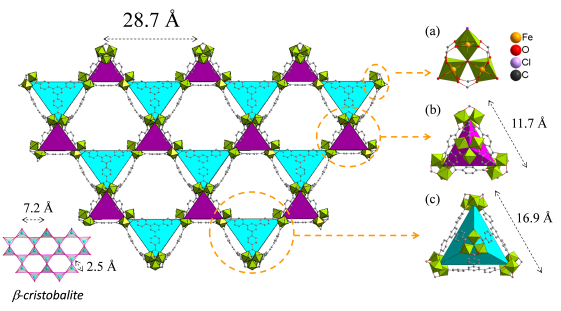MIL-143 or the big-brother (ir)regular β-cristobalite
What does it look like?

Crystallographic representation generated with Diamond.
What is it?
When transition metals meet organic linkers (carboxylates, N-donors such as pyrazine, phosphonates, sulfonates), they can give rise to a 1D-, 2D- or 3D- framework, namely MOFs for Metal Organic Frameworks or PCPs for Porous Coordination Polymers. Indeed, some Coordination Polymers don’t exhibit porosity.
MOFs are crystalline materials and X-ray diffraction is a suitable tool to determine their structure. A majority of MOFs are based on divalent metal (M2+= Zn2+, Cu2+, Co2+, Ni2+, Mg2+, etc…) which gives rise to crystals big enough (from 0.1 to 0.2 millimetres) to be measured on a single-crystal X-ray diffractometer, a well known and successful technique for structure determination. Nevertheless, growing single crystals from trivalent (M3+= Fe3+, Cr3+, Al3+, V3+, Ga3+, In3+, etc…) or tetravalent metals (M4+= Zr4+, Ti4+, Hf4+) is more challenging and scarce and leads often to a powder; crystallographers must thus solve the structure from a powder diffraction pattern which contains much less information than a single-crystal diffractogram. In addition, MOFs crystallinity can be really "bad" and synchrotron measurements are often needed for this technique.
The MOF we’re talking about today, MIL-143(Fe3+) (or Fe3O(Cl-)(H2O)2(bdc)3/2(btb).nsolv), was solved from powder diffraction data and crystallizes in the cubic F23 (no. 196) space group (a=40.8635(1) Å). MIL stands for 'Materials of Institute Lavoisier' and this was the 143rd MOF they made. As there is no classification for MOFs, each lab names its baby after the lab's name so we got some nice names such as HKUST (for instance HKUST-1), CAU, UMCM, UiO, STA, PCN, POST, MOM and so on.
The particularity of MIL-143 is that it is built up from two types of linkers whilst a majority of MOFs contains only one type of linker. Regarding its structure, oxo-centered trimers of iron (III) octahedra (see Figure (a)) constitute the primary building unit. They assemble with the ligands to give rise to two types of super-tetrahedra (ST) (see Figures (b) and (c)). The edges of these ST are 11.7 Å and 16.9 Å (vs 2.5 Å for β-cristobalite), thus the term "big brother", and there are two types of tetrahedral (vs a unique tetrahedral in β-cristobalite) creating an irregularity but the whole structure being regular. The first ST (see Figure (b)) is similar to those being identical to those observed in MIL-101,1 i.e. with terephthalate on the edges and the second ST (see Figure (c)) are similar to those of MIL-100,2 but with the 1,3,5-benzenetrisbenzoate linker instead of 1,3,5-benzenetriscarboxylate on the faces. Indeed, the structure of MIL-143 can be considered as a succession of extended ST of MIL-100 and ST of MIL-101. Similarly to the MIL-100 and MIL-101, this leads to the formation of two sets of mesoporous cages with free diameters of 20 Å and 24 Å.
What is it for?
MOFs have attracted attention due to their high porosity and their promising properties for several potential applications such as gas storage, separation, nano-applications, catalysis, energy storage and more recently biomedicine.3,4
Nevertheless, one of the main issues with MOFs is their low chemical and thermal stability. A large number of MOFs based on M2+ metals are not even stable to air moisture and must be kept in solvent or under inert atmosphere, making their industrial application difficult. By increasing the valence of the metal, one can increase their stability5 but it is not an absolute rule as other parameters can interfere such as the mesoporosity, i.e. containing pores with diameters above 20 Å (N.B: most MOFs are microporous, i.e. below 20 Å). Indeed, MOFs exhibiting mesoporosity tend to be more fragile. MIL-143 is one of them as its mesoporosity is only partially accessible.
Where did the structure come from?
The structure comes from "Me" et al. and was published in 2013 in Angewandte Chemie, Internationale Edition.6
References
(1) Férey, G.; Mellot-Draznieks, C.; Serre, C.; Millange, F.; Dutour, J.; Surblé, S.; Margiolaki, I. Science 2005, 309, 2040.
(2) Férey, G.; Serre, C.; Mellot-Draznieks, C.; Millange, F.; Surblé, S.; Dutour, J.; Margiolaki, I. Angew. Chem., Int. Ed. Engl. 2004, 43, 6296.
(3) Chem. Soc. Rev. 2009, 38, 1203.
(4) Chem. Rev. 2012, 112, 673.
(5) Low, J. J.; Benin, A. I.; Jakubczak, P.; Abrahamian, J. F.; Faheem, S. A.; Willis, R. R. J. Am. Chem. Soc. 2009, 131, 15834.
(6) Chevreau, H.; Devic, T.; Salles, F.; Maurin, G.; Stock, N.; Serre, C. Angew. Chem., Int. Ed. 2013, 52, 5056.






